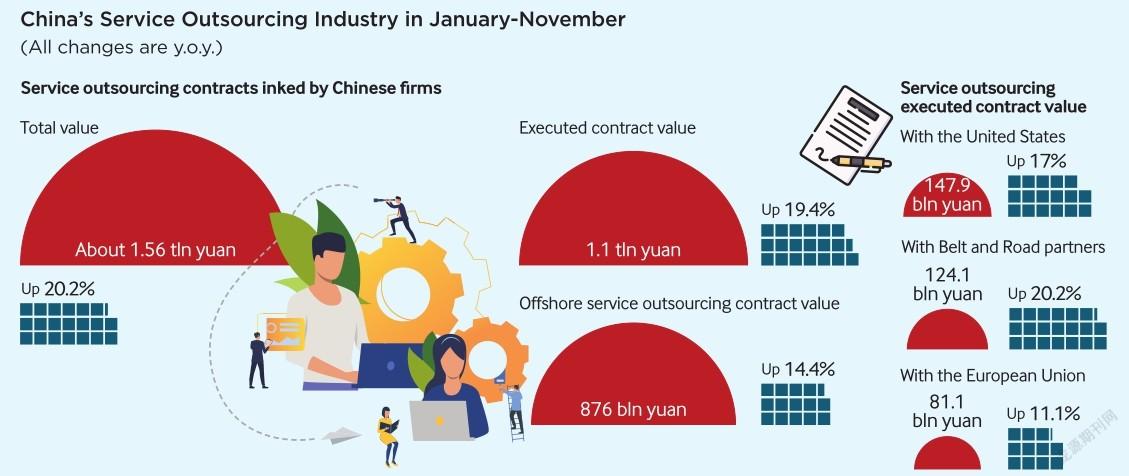OLYMPIC BANKNOTES
2021-01-22

The People’s Bank of China issued 200 million sets of commemorative banknotes for the Olympic Winter Games Beijing 2022 on December 21.
The set includes a polymer note and a paper note, both with a face value of 20 yuan ($3.14). The bills respectively feature a figure skating pair and a freestyle skiing athlete on the obverse and a Winter Olympic venue on the reverse.
A contestant strikes an underwater pose during a mermaid contest in Sanya, Hainan Province, on December 21. Over 40 contestants participated in the competition which started that day.

China’s meteorological authority announced on December 20 that the country has established its first greenhouse gas observation network after nearly 40 years of construction.
The announcement came after the China Meteorological Administration released its first national greenhouse gas observation network directory, which consists of 60 high-precision observation stations covering major critical climate areas in the country.
Its observation elements contain seven types of greenhouse gases specified in the Kyoto Protocol, including carbon dioxide, methane and nitrous oxide.
China is one of the first countries in the world to carry out the background observation of greenhouse gases. In 1982, China’s first regional atmospheric background monitoring station was put into use in Beijing.
Cao Xiaozhong, a senior official with the administration, attributed the establishment of the network to China’s continuous participation in the Global Atmosphere Watch Programme of the World Meteorological Organization.
The administration this year undertook a series of efforts to help China reach its goal of carbon neutrality. In addition to the network, it has established a national greenhouse gas and carbon neutrality monitoring and evaluation center with branches across several provinces, as well as an evaluation system for the effectiveness of its carbon neutrality actions to accurately distinguish natural and manmade carbon fluxes on the global, regional and urban scales, Cao said.
More advanced facilities and monitoring networks will be created in the coming years to provide data support for China’s fulfillment of its carbon peak and carbon neutrality commitments, by 2030 and 2060 respectively, Cao said.
The average life expectancy of Chinese women reached 80.88 years in 2020, up from 77.37 years in 2010, according to the National Bureau of Statistics(NBS) on December 21.
The social status of Chinese women has gone up significantly over the past decade, and their sense of accomplishment, happiness and security has increased dramatically, read an NBS report on the monitoring results of the Outline for the Development of Chinese Women (2011-20).
The gender gap in compulsory education has been eliminated, with the net enrollment rate of primary schoolaged girls remaining above 99.9 percent for six consecutive years since 2015, the same as that among boys.
The presence of women in the workforce has seen a steady increase. There were 67.79 million female employees in urban work units last year, up 39.5 percent from 2010. Women currently account for 43.5 percent of China’s total employment, according to the report.
Although historic progress has been made in promoting gender equality and the allround development of women over the past decade, the report noted that the protection of women’s rights and interests in some fields still requires further consolidation.
China’s central bank launched the issuance of a set of commemorative coins on December 27 in celebration of the upcoming New Year.
The set of three coins, all legal tender, includes one gold, one silver and one two-color copper alloy coins, the People’s Bank of China said in a statement.
The gold and silver coins, with a denomination of 10 yuan ($1.57) and 3 yuan ($0.47), respectively, feature the national emblem on the obverse, according to the central bank.
On their reverse, the coins are inscribed with the Chinese character fu, which represents happiness and good fortune, decorated with multiple Chinese traditional festive designs including plum blossoms and house eaves, the statement further read.
The two-color copper alloy coin, with a denomination of 10 yuan, features the image of a tiger with elements of traditional Chinese paper-cutting patterns and New Year prints, said the central bank.
More than 60 rare-disease drugs have been approved for marketing in China, over 40 of which are included in the national medical insurance system, according to official data.
China’s medicare reimbursement list now covers medications for 25 rare diseases, according to figures released at a national conference on rare diseases in Beijing on December 18.
Seven rare-disease drugs have been added to the list in 2021, bringing their price down by about 65 percent on average, Li Tao, an official with the National Healthcare Security Administration, said at the conference.
Official data show there are about 20 million rare-disease patients in China, with more than 200,000 new patients added every year.
According to Chen Shifei, deputy head of the National Medical Products Administration, drugs for rare-disease prevention and treatment have received priority in China’s review and approval process for new medications.
Visitors take to the ice slide at an ice and snow art festival in Wuhan, Hubei Province, on December 21.

China is deliberating a new law to protect the fertile black soil in its northeastern provinces as part of the efforts to ensure the country’s food security and protect the ecosystem, Xinhua News Agency reported on December 20.
The draft law was submitted for its first reading on December 20 at an ongoing session of the Standing Committee of the National People’s Congress.
The black soil found in China’s northeastern provinces of Heilongjiang, Jilin and Liaoning and in some parts of the Inner Mongolia Autonomous Region, produces about one quarter of the country’s total grain output, making it key to China’s food supply.
But years of excessive reclamation have eroded its nutrients and the chernozem layer is thinning, threatening the country’s ecological security and sustainable agricultural development. Consequently the country is in need of measures designed to specifically protect the black soil.
China had offered rehabilitation assistance to 332,000 children with disabilities as of November this year, nearly 50,000 more than the total of 2020, according to a recent statement from the China Disabled Persons’Federation (CDPF).
With the Central Government’s additional injection of 400 million yuan($62.86 million) compared with 2020, disabled persons’federations across the country, in cooperation with the relevant departments, provided higherstandard assistance to more physically and mentally impaired children, the CDPF said on December 15.
The CDPF further entrusted third-party organizations to conduct satisfaction surveys among parents to boost the quality of assistance services.
Children learn how to make dumplings in celebration of the Winter Solstice or Dongzhi at their school in Wuan, Hebei Province, on December 21. Winter Solstice, the shortest day of the year and one of the 24 solar terms, falls on December 21 this year. In Chinese culture, it marks the beginning of deep winter as well as a time for family gatherings. North China has maintained the tradition of feasting on dumplings on this day, whereas people in the south eat tangyuan, or rice ball soup.

The number of enterprises listed on the Chinese A-share market through initial public offerings(IPOs) and the funds raised hit a record high this year, China Securities Journal reported on December 22, citing data from financial information provider Wind.
As of the day, a total of 508 companies were listed on the A-share market, up 16 percent from the annual figure in 2020. They raised 527.3 billion yuan($82.77 billion), an increase of 9.7 percent compared with the total of last year.
Over 70 percent of the IPOs were issued through the registration-based system, with 386 firms listed on the Nasdaq-style sci-tech innovation board, the ChiNext board and the Beijing Stock Exchange (BSE), according to the report.
The number of IPOs on the Chinese A-share market is expected to further increase in 2022 due to the smooth operation of the BSE, sci-tech innovation board and the ChiNext board, and more reform measures of the registration-based system, said a report released by international consulting firm Deloitte.
The Chengdu-Chongqing economic circle will boost 160 key projects in 2022, with a combined investment of roughly 2 trillion yuan ($313 billion), amid the country’s efforts to foster a key growth powerhouse in the western region, local authorities said.
The circle is another important regional development strategy, following the BeijingTianjin-Hebei region, the Yangtze River Delta and the GuangdongHong Kong-Macao Greater Bay Area.
In October, central authorities issued a master plan for developing the area.
By 2025, the circle will witness significant increases in economic strength, development vitality and international influence, and about 66 percent of its permanent residents are expected to be residing in urban areas, the plan read.
Covering about 185,000 square km, the circle takes up 1.9 percent of the country’s total land territory. In 2019, it had a permanent population of around 96 million and a GDP of 6.3 trillion yuan ($988.4 billion), accounting for 6.9 percent and 6.3 percent of the national total, respectively.
Governments at all levels invested 7.5 trillion yuan ($1.2 trillion) in the transportation sector during the 13th Five-Year Plan (2016-20) period, driving related fixed assets investment to more than 16 trillion yuan ($2.5 trillion), according to the Ministry of Finance.
During the timespan, 5.69 trillion yuan ($892.7 billion), 1.16 trillion yuan ($182 billion), 390 billion yuan ($61.1 billion) and 230 billion yuan ($36 billion) were respectively directed to the highway, railway, civil aviation and water transport sectors.
Government investment in transportation also served to support poverty alleviation efforts, the coordinated development of regional transportation, and the fight against COVID-19, the ministry said.
A total of 382 new public-private partnership (PPP) projects were registered in the first 11 months of the year, data from the National Development and Reform Commission showed.
Urban infrastructure saw 144 projects added during the period, the largest increase among all sectors, according to the commission.
Sectors including agriculture, forestry, water conservancy, social development, transport and environmental protection also reported many new PPP projects in the JanuaryNovember period.
PPPs act as collaborative investment models between the government and private companies.
Shipments of China’s commercial large screen sector are expected to grow 11.4 percent year on year to 9.53 million in 2022, according to research firm International Data Corp. (IDC).
The total shipments of interactive whiteboard will reach 2.18 million next year, up 17.8 percent from a year ago.
Advertising machines will see the largest growth of 33.9 percent thanks to increasing demand from the retailing industry that has seen rapid digital transformation, the IDC data showed.
The firm expects next year’s commercial TV and splicing liquid crystal display screen to tick up 4.5 percent and 11.6 percent, respectively.
By 2023, about 28 percent of commercial display manufacturers will have the ability to provide visual solutions in smart scenarios due to accelerated integration between industries.
There are over 1.3 million 5G base stations in China, with the number of 5G users reaching 497 million, Minister of Industry and Information Technology Xiao Yaqing announced on December 20.
In 2022, the country will further boost its information and communication technologies and expand the coverage of 5G services and gigabit fiber optic networks in stable and orderly manner, Xiao added.
China expects to see the number of 5G users exceed 560 million by 2023, according to a guideline released in July.
By that time, the 5G network is expected to be used by over 40 percent of personal mobile phone consumers, and every 10,000 people in China will enjoy more than 18 5G base stations, the guideline concluded.
China’s GDP in 2020 was revised to 101.36 trillion yuan ($15.9 trillion), data from the final verification conducted by the National Bureau of Statistics(NBS) showed on December 17.
The amount represents a reduction of 241.9 billion yuan($37.9 billion) from the preliminary calculation.
At constant prices, the 2020 GDP increased 2.2 percent year on year, down 0.1 percentage point from the preliminary calculation, according to the NBS.
China’s annual GDP goes through two sets of accounting in accordance with the current national economic accounting system. The preliminary calculation will be revised during a final verification based on the annual statistical data, fiscal final accounts and departmental administrative records.
Chinese auto companies exported 1.79 million cars during the first 11 months of the year, more than double the figure from the same period last year, the latest industry data presented.
Driven by robust outbound demand for new-energy vehicles, auto exports surged 59.1 percent year on year to 200,000 units in November alone, according to the China Association of Automobile Manufacturers.
Exports of passenger cars soared 71.2 percent from a year ago to 170,000 units in the month, while those of commercial vehicles rose 13 percent year on year to 30,000 units.
Exports of new-energy vehicles skyrocketed 189.9 percent from a year ago to 37,000 units in November.
($1=6.38 yuan)


